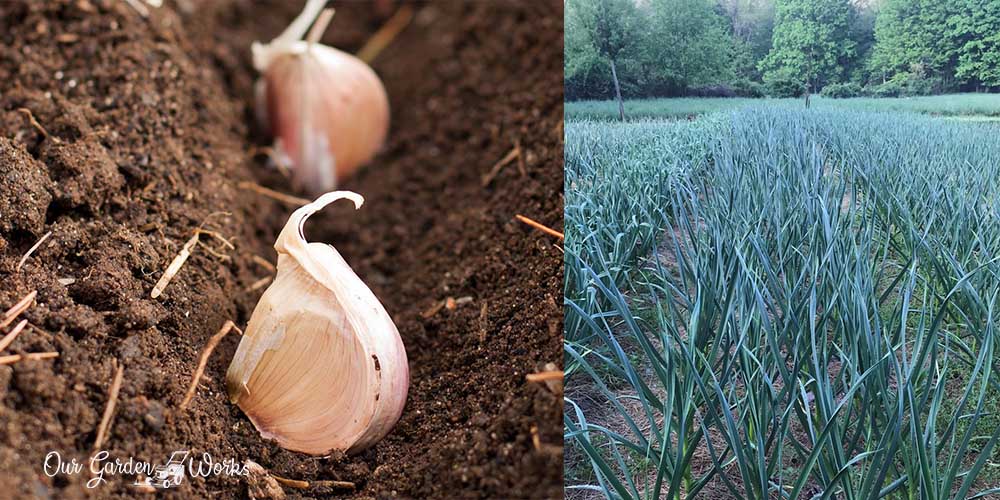If the pandemic gave you some interest in gardening, learning how to grow garlic in the fall might be a good leisure activity for you.
Garlic belongs to the perennial bulb family that includes onions and leeks. It is easy to grow and doesn’t take up much space like other vegetables.
Why do you need to plant garlic in the fall, you may ask. Well, garlic needs the full sun during summer to provide a quality and bountiful harvest.
In some regions, planting them during fall helps jumpstart their growth by developing strong roots and get more time to develop the bulbs in spring and summer.
What is The Best Time To Plant Garlic in The Fall?
The best time to plant garlic in your garden is on or later than the autumnal equinox or the two weeks before the frost date in your region.
You may also plant them in early spring. However, the planting approach would be a little different.
Planting garlic in the fall helps it grow some roots before the frost comes and it becomes dormant. As the springtime comes, new shoots from the cloves will start to pop up and develop through the growing season.
Parts And Types of Garlic
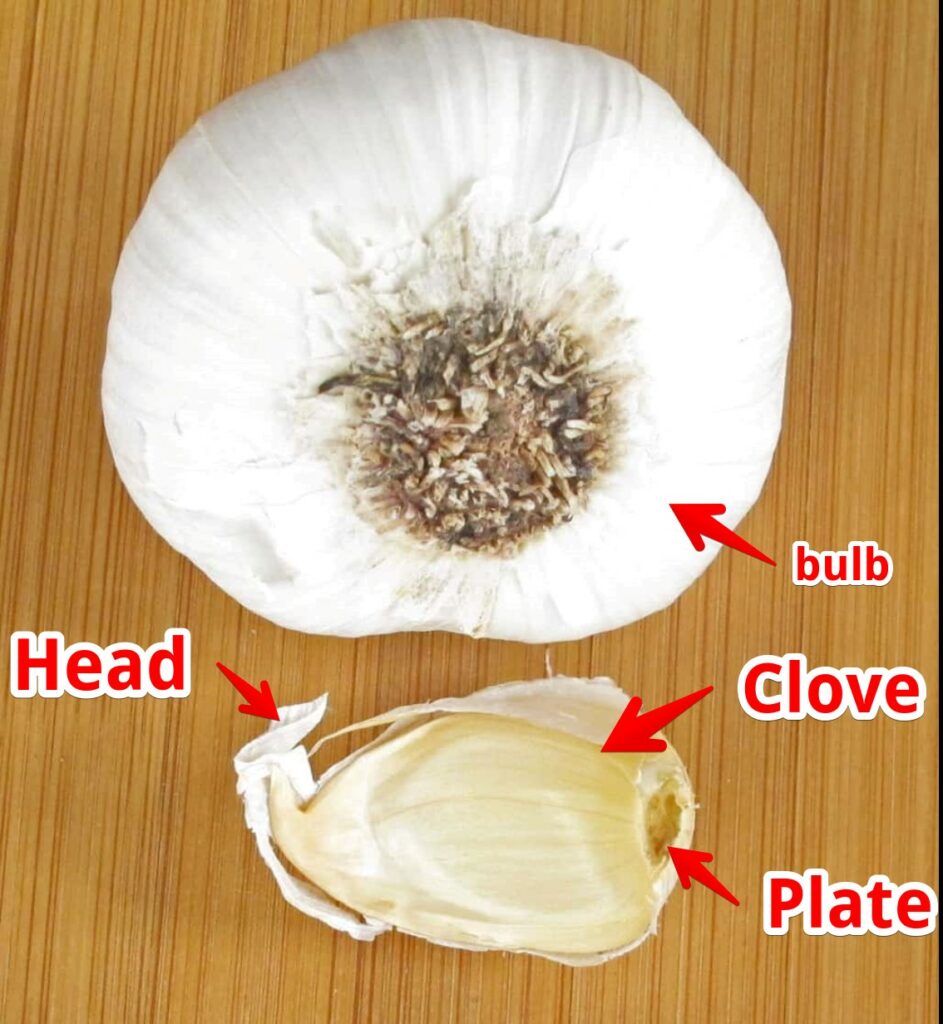
Before we head to the planting section, it’s best to learn about the parts of the garlic, so you’ll know how to place them properly in the ground.
Here’s what you need to look out for:
- Bulb: pertains to the whole garlic, wrapped in a papery cover, and contains multiple cloves. It is also called a head or a knob.
- Clove: The multiple lobes found inside the papery skin of a bulb.
- Plate: A part of the bulb where the roots sprouts.
- Head: The top part of the garlic that connects to its leaves.
- Scape: The hard stalk that sprouts during the development of garlic. It holds the flower and the seeds of garlic. This part is also edible and usually cut off to promote the development of garlic leaves.
Now let’s head over to the two types of garlic that you can choose to grow:
- Softneck garlic: This type of garlic doesn’t develop a white center stalk. It also has several layers of cloves that can go for up to 40 cloves. It also has a milder taste than hard neck garlic that can last in storage longer lasting up to six months. The braided garlic you see in the farmer’s market is made of soft neck garlic.
- Hardneck garlic: This type has a hard center stalk called a scape. It usually has fewer cloves but has a stronger and hotter flavor. However, they have a shorter shelf life, lasting for 3 months.
How To Plant Garlic in The Fall?
As long as you have garlic in the kitchen, you can already grow garlic in your garden. To form big bulbs, it’s essential to prepare nutrient-dense soil for them.
Soil Preparation
Nourish your garden bed before you start planting. Here are the things you can add to the soil to make it suitable for garlic:
- 4 inches of aged compost or earthworm castings
- General fertilizer designed for vegetables (10-10-10)
To promote better absorption of nutrients from the soil, you must set the soil acidity applicable for garlic. Garlic varieties thrive in a soil PH level of 6.0 to 7.0.
You can use a soil PH tester to check if you got the soil acidity right. The soil should also be loose enough to allow the oxygen to get to the roots.
Planting
Now that the soil is ready, you can now start preparing the cloves you’re about to use. Start by:
- Remove the cloves from the bulb without damaging the plate and tip. Try not to remove their skin as well. If you happen to damage the plate of a clove, you can set it aside and use it for cooking.
Some gardeners use hacks to speed up the root development of the cloves and keep root problems at bay. Though it’s optional, you can soak the cloves in a mixture of two cups of water and a teaspoon of baking soda overnight.
- You can either plant the cloves in two rows or a single row. Either way, plant them four to six inches apart and 2 inches deep. The rows should be 10 to 14 inches apart.
- Apply 8 inches of mulch to retain the temperature in the soil and protect the cloves from frost. In a few weeks, the mulch will be set to 2 inches.
- Water them one inch per week aside from rainfall.
- For hard neck garlic, remove the scapes or the stem that produces flowers to boost the development of the bulb. The scape is edible and tastes best when stir-fried.
Fertilization and Watering Requirements
Once the seedlings have started to pop up in spring and become six inches tall, you can start fertilizing your garlic with the fertilizer of your choice, compost, and worm castings.
The best fertilizer for garlic according to most gardeners include:
- Neptune’s Harvest Fish & Seaweed Fertilizer (Liquid fish emulsion)
- UNCO Worm Castings Organic Fertilizer
Garlic is drought-resistant but it needs water from time to time when there is no rainfall for 7 to 14 days.
In late summer when the lower leaves start to turn brown or two weeks before harvest time, you can stop watering the garlic to let the papery covers get dry.
Pest, Fungi, and Weed Control
When it comes to weeds, garlic plants don’t have enough fighting chance to compete and wilt.
So you have to check them from time to time and uproot some of the pesky weeds.
When it comes to pests, the common ones include:
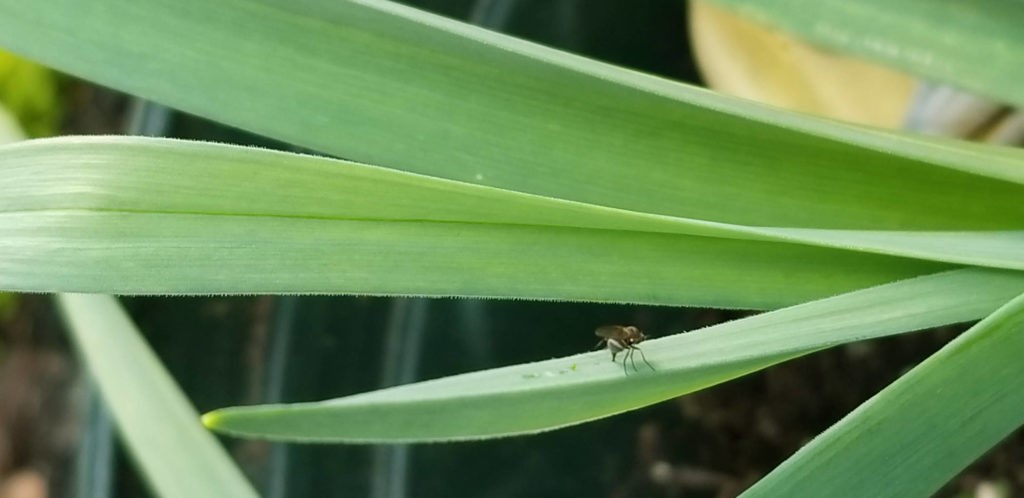
Allium leafminer is an invasive fly that feeds on allium insects such as garlic, leeks, and onion. It’s a fly with a grayish color that feeds on the sap of plants in the allium family.
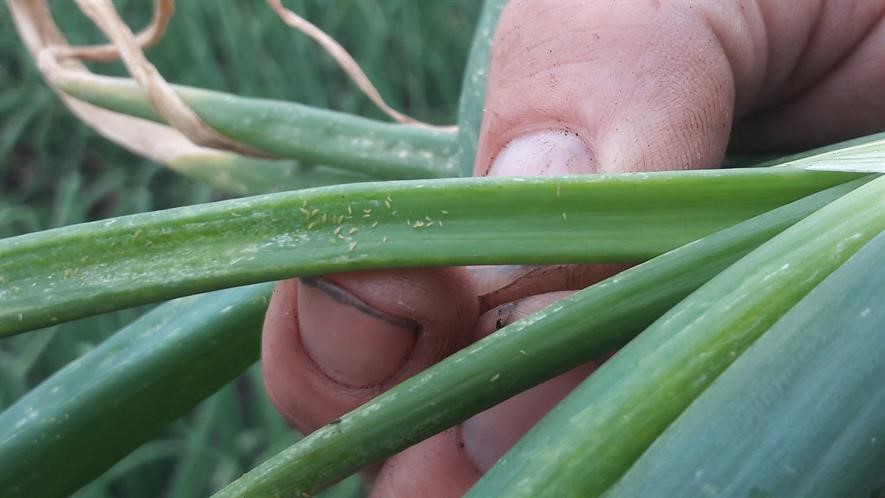
Garlic thrips are small insects that come in yellow and black and lay eggs on the leaves of garlic. They can leave scars on the leaves.
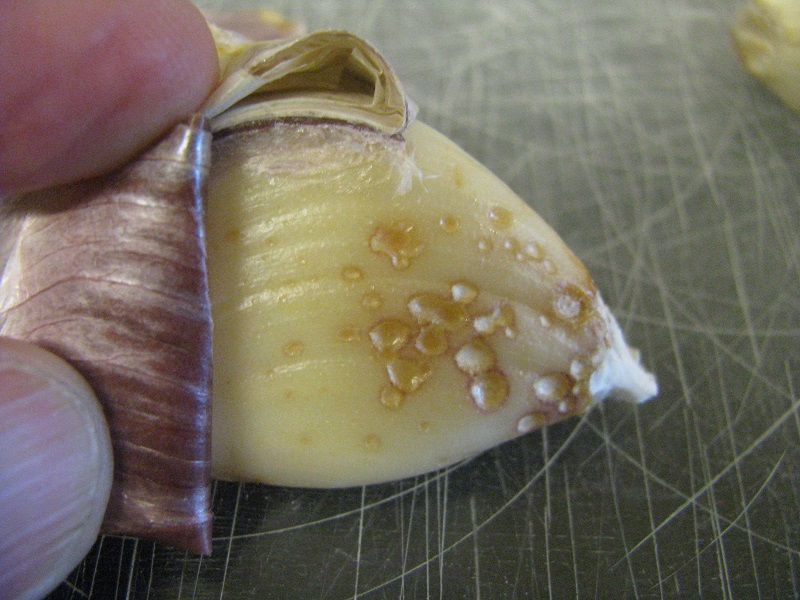
Bulb mites are small insects in the soil that has a creamy-white color with brown legs. They attack garlic cloves in their damaged part above the root plate.
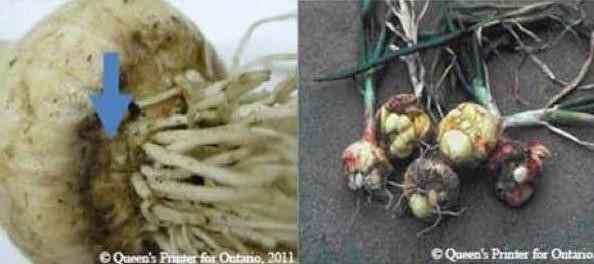
Garlic bloat nematode is a microscopic roundworm that can infiltrate the plant and feed on the bulb. The concentration of nematodes forms wool between the scales of the bulb.
To address the common pests in your garden, here are some of the best pest control strategies for garlic:
Your garlic plants may also get fungal diseases during their growing period. The common fungal diseases that can affect the quality of garlic are as follows:
- Botrytis leaf blight
- Downy mildew
- Purple blotch
To prevent or treat fungal diseases in your garlic plants, you should look for chlorothalonil-based products.
Some of the best fungicides in the product that contains this compound include:
Harvesting, Curing, and Storing Garlic
Harvest garlic in late June or the first week of July. The signs that garlic is ready for harvesting is when the lower leaves start to turn yellow and get dry. You may also check a sample by pulling one garlic from the ground.
As soon as you notice that garlic is ready to harvest, dig the bulbs using a shovel Keep the roots and leaves intact. The leaves will help hold the garlic as you cure or dry them. Collect the garlic in bundles and place them in a dry and well-ventilated area for 4 to 6 weeks.
As soon as the garlic is dried properly, You can trim off the excess roots and cut its head into an inch. Some gardeners that harvested soft neck garlic braids the stem and leave them hanging in bunches in the kitchen.
Store garlic in a dry area and away from moisture. When garlic and onions get wet or soaked, they may develop mold and get spoiled. In some regions, fresh garlic leaves are also used as a garnish or a stir-fried side dish.
Frequently Asked Questions (FAQs)
Should you water garlic after planting in the fall?
It’s not necessary to water newly planted garlic in the fall. It is a drought-resistant plant but you should water it when the soil gets too dry or didn’t receive any moisture for 7 to 14 days.
How deep do you plant garlic in the fall?
Plant garlic about 2 inches deep in the soil. Make sure to place the root plate at the bottom and the head of the clove at the top when you plant the cloves.
To protect the cloves from frost, place 4 to 8 inches of seedless straw on top of the soil.
How long do you soak garlic before planting?
Soak the garlic cloves in a mixture of water and a teaspoon of baking soda 24 hours before you plant them. Soaking helps speed up the root development of the cloves and protects them from root problems like root rot.
How often do you water garlic plants?
Garlic doesn’t like too much moisture in the soil. You should only water them to an inch every week including rainfall. Overwatering garlic may cause the roots to rot or attract other fungal diseases.
Do you peel garlic before planting?
You can peel the papery cover of a bulb but not the cloves. The cloves must be intact and the root plate must not be damaged.
If you damage the root plate or the hard part at the bottom of the clove, do not plant it and just use it for cooking.
How long does garlic take to grow?
Garlic takes about 6 to 7 months to grow. It is planted in the fall in some regions to help jumpstart the root development of the clove and give it more time to develop during spring and summer.
The quality is also better when you plant them months before spring.
What happens if you plant garlic too early?
If you plant garlic too early, it will grow roots and sprout a new stem that will stick out in the ground throughout winter. The new sprouts may not withstand the harsh winter temperatures and cause the plant to die.
How late can I plant garlic?
The latest time to plant garlic is a week before the first frost. The cloves must be established under the soil before the ground freezes. Otherwise, the cloves will not have enough time to adapt to the soil and fault to develop roots before winter.
Can you use garlic straight from the ground?
Yes. You can use garlic straight from the soil. However, curing newly harvested garlic helps extend their shelf from 3 to 6 months, depending on the variety that you planted.
How long does garlic need to cure?
It takes about 2 to 4 weeks for the garlic to be completely cured. The curing process removes the excess moisture from the bulb and makes it stay fresh for up to six months.
Can you plant raw garlic?
No. You should use a clove of garlic with intact skin and a root plate. The root plate is where the bulb will start to grow new roots and the clove is where new cloves start to develop. Raw garlic doesn’t have the parts that will allow it to grow new parts.
Final Thoughts
We hope that this post has helped you learn how to plant garlic in the fall. Garlic is easy to grow and doesn’t require fuzzy caring techniques like other vegetables.
Aside from adding spice and extra flavor to your food, garlic is also used as a medicine. Its antibacterial properties are helpful in cleaning wounds and as a natural antibiotic.
If you find this post helpful, please share it with your friends. For more gardening and tips for a sustainable lifestyle, tune in to our weekly blogs and learn more while staying at home.
How was your experience in growing garlic plants? Let us know in the comments section below.
